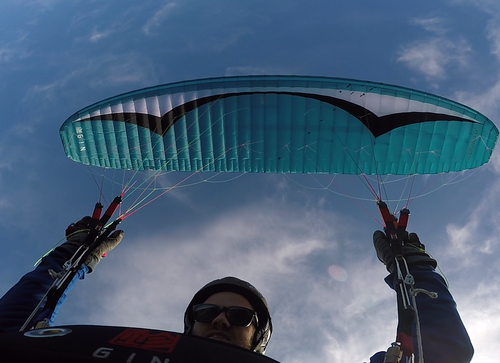GIN Bolero 5 M |
|||||||||||||||||||||||||||||||||||||||||||||||||||||||||||||||||||||||||||||||||||||||||||||||||||||||||||||||||||


|
|||||||||||||||||||||||||||||||||||||||||||||||||||||||||||||||||||||||||||||||||||||||||||||||||||||||||||||||||||
Instability rating |
|||||||||||||||||||||||||||||||||||||||||||||||||||||||||||||||||||||||||||||||||||||||||||||||||||||||||||||||||||
|
|||||||||||||||||||||||||||||||||||||||||||||||||||||||||||||||||||||||||||||||||||||||||||||||||||||||||||||||||||
Glider characteristics |
|||||||||||||||||||||||||||||||||||||||||||||||||||||||||||||||||||||||||||||||||||||||||||||||||||||||||||||||||||
|
Launch preparations: average
launch characteristics: balanced, climbs constantly, no guidance necessary, good feedback during inflation, no braking required, slows before zenith, control check simple, low takeoff speed
asymmetric collapse: canopy colllapses at high angle to leading edge, moderate dynamics, total course change 180-270°, (3), moderate course change rate, moderate forward pitching 45-60°, (2), high height loss 40-49 m, (3), moderate sink velocity 15-19 m/s, (2), G-Force 2,5- 2,9 G, (2)
Frontal collapse: canopy collapses with high total collapse aera, moderate pitch backwards 30-45°, moderate pitch forwards 30-45°, moderate dynamics, course change <90°, (2), immediate automatic recovery, usually symmetric recovery, immediate return to normal airspeed, moderate height loss 30-39 m, (2), low sink velocity 10-14 m/s, (1)
Spiral dives: rapid sink velocity increase, High G-Force 4,0-4,5 G, (3), Sink velocity after 720° <18 m/s, (3), High maximum sink velocity < 22 m/s, (3), sink velocity increase < 6 m/s on brake release, (2), Course change 540-720° after spiral exit, (4), high height loss during recovery 60-100 m, (3)
B-Stall: high force required, low pitch backwards <15°, low pitch forwards <15°, stable sink phase, no tendency to deform, immediate return to normal airspeed, 6-8 m/s, height loss on recovery < 20 m
big ears: simple initiation, stable flight phase, immediate automatic recovery, Vsink unaccelerated 3-3,5 m/s, Vsink accelerated 3,5-4 m/s, Vunaccelerated 0-3 km/h less than trimspeed, Vaccelerated 3-5 km/h faster than trimspeed
Steering behaviour: balanced, 80 cm brake travel range, very noticable brake pressure increasse, Late stall point, easily identifiable |
|||||||||||||||||||||||||||||||||||||||||||||||||||||||||||||||||||||||||||||||||||||||||||||||||||||||||||||||||||
Notes |
|||||||||||||||||||||||||||||||||||||||||||||||||||||||||||||||||||||||||||||||||||||||||||||||||||||||||||||||||||
|
Take-off: The takeoff preparations were average. The gallery lines were a bit confusing compared to the rest of the line set. The riser is simple and clear. The lines are colorful separated. The takeoff itself is very easy. After a short impulse, the glider climbed straight and self-sufficient without any help of the pilot. It is not necessary to stop the glider with after the climbing with a lot of brake. Flight: The glider has a balanced handling and is quite good damped on every axis. The brake pressure increases a lot on the way to the stall. Asymmetric Collapse: Trimspeed: It was hard to pull surfacedeep collapses. The glider showed a slow pitch- and turnmovement. The pitch forward was between 55° to 60°. The glider opened after 90°. All in all the glider turned 180°. Accelerated Collapse: It was possible to pull surfacedeep collapses. The pitch- and turnmovement was a bit faster. The glider opened after 180°. The overall turning was around 270°. The pitch forward was at 60°. All in all the glider showed less dynamic but the pitch und turning was on the border to the next higher SafetyClass. Front Collapse: The glider opened always fast with less dynamic. The glider opened most of the time symmetrical. Sometimes the glider opened asymmetrical. This caused a turning less the than 90°. Spiral-Dive: Due to the strong increase of the brakepressure the spiral needs to be entered certainly. Unintended Spiralentries are almost impossible for beginner pilots. The glider is easy to control during the maneuver. After the release of the brake the glider increased its sinkrate with around 10 m/s during one full 360° turn. The glider stopped the spiral a little bit delayed by itself. Overall turning was around 540°. Sometimes it took little bit longer to exit and the overall turning was around 700°. B-Stall: It was hard to pull and hold the B-Stall. No problems occurred during the maneuver and the exit. Big ears. No problems. |
|||||||||||||||||||||||||||||||||||||||||||||||||||||||||||||||||||||||||||||||||||||||||||||||||||||||||||||||||||
Rating |
|||||||||||||||||||||||||||||||||||||||||||||||||||||||||||||||||||||||||||||||||||||||||||||||||||||||||||||||||||
|
Safety class 4 This class of paraglider reacts demandingly to one or more of the following manoeuvres: frontal collapse, asymmetric collapse or spiral dive.Demandingly means that the above manoeuvres result in marked dynamic reactions from the glider and/or large height losses. Advanced piloting skills which need to be regularly practised, together with good personal reaction times are required to safely fly this class of gliders. Basic recovery techniques for ending a manoeuvre are not sufficient to maintain control, reduce height loss to a minimum and prevent subsequent critical reactions. Pilots should be able to recognise the onset of the above manoeuvres and be able to prevent or minimise their effects through immediate and precise pilot inputs. Additional experience such as regular ground handling and SIV training is required to safely fly gliders of this class. Special training or pilot skills which exceed standard training may be required for the safe performance of emergency descent techniques. Gliders of this Safety Class are not suitable for beginners, irregular flyers or low-airtime pilots. |
|||||||||||||||||||||||||||||||||||||||||||||||||||||||||||||||||||||||||||||||||||||||||||||||||||||||||||||||||||

